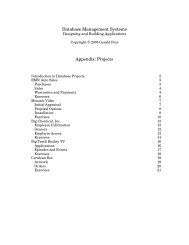Revision History - Jerry Post
Revision History - Jerry Post
Revision History - Jerry Post
Create successful ePaper yourself
Turn your PDF publications into a flip-book with our unique Google optimized e-Paper software.
Tennessee Valley Authority (TVA)<br />
The Tennessee Valley Authority (TVA) is a quasi-public federal organization headquartered<br />
in Knoxville, Tennessee, that was founded in 1933. It provides electric power;<br />
flood control; navigation; and agricultural, economic, and industrial development through<br />
the Southeastern United States. It is the nation’s largest electric utility. It makes most of<br />
its money ($6.9 billion in 2003) by selling electric power to regional power associations. It<br />
provides power to more than 160 municipal and cooperative power distributors who service<br />
more than 7 million consumers. In addition, special projects are funded by Congress<br />
(amounting to $135 million in 1992). The 13,000 employees (down from 19,000 in 1992) are<br />
divided into several business units, including finance, power generation, marketing, and<br />
navigation. The IS department consists of 683 employees (down from 925 in 1992) and has<br />
an annual budget of $100 million [Garvey 2003]. However, the company employs 4,000 union<br />
trade workers (such as electricians) on a seasonal basis to handle maintenance [Hoffman<br />
2004].<br />
Like other businesses, the TVA faces a changing environment with deregulation. For<br />
Revenue (Million $)<br />
Year 2003 2002 2001 2000 1999<br />
Revenue 6,952 6,796 6,999 6,762 6,595<br />
Net Income 456 73 (3,311) 24 119<br />
years, it was<br />
the only supplier<br />
of electricity<br />
in its<br />
region—<br />
cooperatives<br />
and municipalities signed agreements to purchase power solely from TVA. Many of these<br />
contracts had extended time frames of 35 to 50 years. Many of these contracts were due for<br />
renegotiation in the 1990s, and other utilities are eager to expand their markets. Additionally,<br />
the federal government is encouraging competition in the production of electricity. As<br />
a result, TVA has to become more cost conscious. As of 1994, the Energy Policy Act of 1992<br />
effectively frees customers to choose the electric company they wish to use. Wholesale corporate<br />
utility customers can already buy their electricity from a variety of sources. It is unclear<br />
at this time whether individual households will have the option of selecting power<br />
providers. The act is primarily designed to provide multiple choices to large factories, power<br />
distributors/resellers, and municipal utilities.<br />
Management and Employees<br />
The TVA is governed by a three-person board of directors, with one of them appointed<br />
as the head of the board. The three members are appointed by the U.S. President, and<br />
the spots are often given to financial backers as political patronage. The day-to-day activities<br />
are governed by the general manager, the comptroller, the general counsel, the chief<br />
budget officer and the director of information. The separate business units are largely independent<br />
of each other. They have separate divisional leaders, separate budgets, and different<br />
objectives that occasionally conflict. Also, many of the offices are located in different cities.<br />
The TVA has an interesting history in terms of management and labor relations. Although<br />
it is technically an agency within the federal government, its employees are not subject<br />
to Civil Service regulations. Congress decided that because of the technical nature of<br />
the agency, it required highly trained employees, so it should be free to hire employees from<br />
the national job market without the political considerations involved in the Civil Service<br />
8







